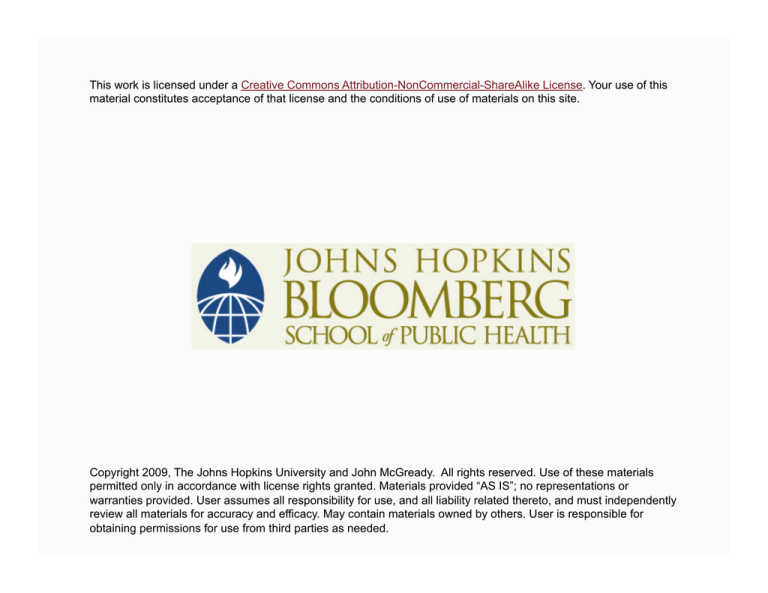
This work is licensed under a Creative Commons Attribution-NonCommercial-ShareAlike License. Your use of this
material constitutes acceptance of that license and the conditions of use of materials on this site.
Copyright 2009, The Johns Hopkins University and John McGready. All rights reserved. Use of these materials
permitted only in accordance with license rights granted. Materials provided “AS IS”; no representations or
warranties provided. User assumes all responsibility for use, and all liability related thereto, and must independently
review all materials for accuracy and efficacy. May contain materials owned by others. User is responsible for
obtaining permissions for use from third parties as needed.
Lecture 5b: Practice Problem Solutions
John McGready
Johns Hopkins University
Hourly Wages
1. Recall the MLR relating hourly wages to years of formal education
and worker’s sex? (1 = female, 0 = male). Years of education in this
sample ranged from 2 to 18 years.
3
Hourly Wages
1. Recall the MLR relating hourly wages to years of formal education
and worker’s sex? (1 = female, 0 = male). Years of education in this
sample ranged from 2 to 18 years.
a) What does the model estimate for the mean difference in
hourly wages for male workers with 16 years of education
compared to male workers with 12 years of education?
-
The slope estimate for years of education,
(edlevel),
quantifies the sex adjusted relationship between wages and
years of education, per one year increment. The comparison
here is for a four-year difference in years of education, so the
resulting mean difference in wages estimate is
4
Hourly Wages
1. Recall the MLR relating hourly wages to years of formal education
and worker’s sex? (1 = female, 0 = male). Years of education in this
sample ranged from 2 to 18 years.
b) Compute a 95% CI for the true mean difference in hourly wages
for the same comparison in part a.
-
Recall, the resulting estimated mean difference is given by
A 95% for 4β1 is
Notice this
is equivalent to
, which can be easily obtained by
multiplying the endpoints from the 95% CI for β1 given in the
Stata output: (4*0.60, 4*0.90) gives a 95% CI of ($2.40/hr,
$3.60/hr).
5
Hourly Wages
1. Recall the MLR relating hourly wages to years of formal education
and worker’s sex? (1 = female, 0 = male). Years of education in this
sample ranged from 2 to 18 years.
c) What does the model estimate for the mean difference in
hourly wages for female workers with 16 years of education
compared to female workers with 12 years of education?
-
There are no extra computations needed; this is exactly the
same as the answers to part a.
6
Hourly Wages
d) What does the model estimate for the mean difference in hourly
wages for female workers with 16 years of education compared to
male workers with 12 years of education?
-
Notice that this cannot be answered using just one slope from
the regression. Let’s write out what the equation predictions
for both of the groups we are considering.
-
F, 16 years of education:
-
M, 12 years of education:
-
The difference in these two estimates is as follows:
7
Hemoglobin
2. Recall the MLR relating Hb to PCV and age. In this sample, PCV
ranges from 25% to 55%; age ranges from 20 years to 67 years.
8
Hourly Wages
2. Recall the MLR relative Hb to PCV and age. In this sample, PCV
ranges from 25% to 55%; age ranges from 20 years to 67 years.
a) What does the model estimate for the mean difference in Hb
for 60 year old subjects with PCV of 40% compared to 60 year
old subjects with PCV of 32%?
-
The slope estimate for packed cell volume (PCV),
,
quantifies the age adjusted relationship between Hb and PCV
per 1% increment. The comparison here is for an 8-percent
difference in PCV among persons of the same age (60), so the
resulting mean difference in Hb estimate is as follows:
9
Hourly Wages
2. Recall the MLR relative Hb to PCV and age. In this sample, PCV
ranges from 25% to 55%; age ranges from 20 years to 67 years.
b) Compute a 95% CI for the true mean difference in Hb levels for
the same comparison in part a.
-
Recall, the resulting estimated mean difference is given by
A 95% for 8β1 is
Notice this is
equivalent to
, which can be easily obtained by
multiplying the endpoints from the 95% CI for β1 given in the
Stata output: (8*0.04, 8*0.17) gives a 95% CI of 0.32g/dL, 1.36
g/dL).
10
Hourly Wages
c) What does the model estimate for the mean difference in Hb for 60
year old subjects with PCV of 40% compared to 50 year old subjects
with PCV of 32%?
-
Notice that this cannot be answered using just one slope from
the regression. Let’s write out what the equation predictions
for both of the groups we are considering.
-
60 year olds, PCV = 40%:
-
50 year olds, PCV = 32%:
-
The difference in these two estimates is as follows:
11




